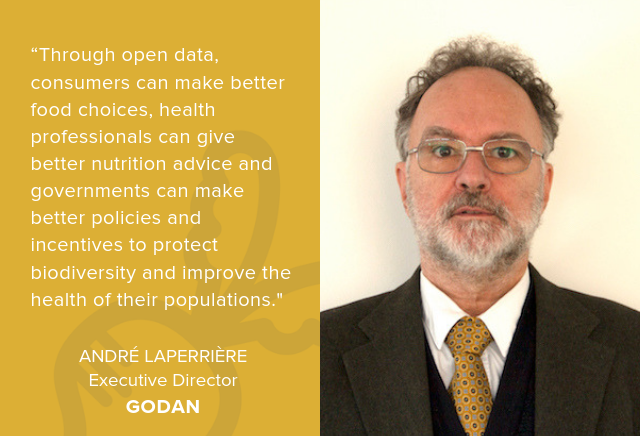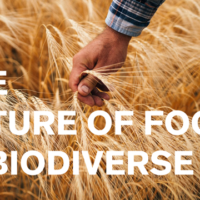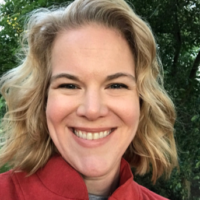
Food+Tech Connect and The Future Market are hosting Biodiversity: The Intersection of Taste & Sustainability, an editorial series featuring interviews with over 45 leading food industry CEOs, executives, farmers, investors and researchers on the role of biodiversity in the food industry. Read all of the interviews here.
Data will be key to creating a biodiverse future. The Global Open Data for Agriculture and Nutrition (GODAN) has created a global coalition of over 850 governments, academia, researchers, private companies and farmers to ensure food security and to preserve biodiversity through the sharing of open agricultural and nutrition data.
Below, I speak with GODAN executive director André Laperrière about how open data can be used to help eaters, health professionals and governments improve public health and preserve biodiversity. He also shares great examples of initiatives to protect biodiversity, like Biodiversity in Standards and Labels for the Food Industry, an EU-based project aiming to standardize biodiversity criteria and labeling standards and to encourage manufacturers and retailers to include biodiversity criteria in their sourcing guidelines.
_________________________
Danielle Gould: How does your organization define and think about biodiversity?
André Laperrière: Biodiversity is a critical element of the world’s ecosystem. As we are learning, the combination of all species currently inhabiting our planet creates a balance that allows for each, including us, to survive, thrive and contribute to each other species development. Every time a species become extinct, it creates a misbalance in the world’s life equilibrium. This is the first reason why biodiversity is important.
The second important element is that there are still thousands of species yet to be discovered, from fungus to mammals in the seas and land alike. These may be part of the discovery for cures and diseases affecting human life, as better knowledge of the specifics of livings whose existence we are aware of, will also lead to medical and nutrition progress, unless we fail to protect them.
Third reason why biodiversity is important is nutrition. Since 1900 the world has lost 75 percent of its crops variety, meaning we grow on average only 25 percent of crops we used to grow for human consumption. As we know, 75 percent of the world’s food is generated from only 12 plants and five animal species, as few as 3 crops in some countries. Consequence: much less diversity in human food consumption, resulting in various forms of mal/incomplete nutrition problems. Fortunately, some countries are beginning to address that; in the most recent Food Security Index, for instance, South Korea won the palm, with its agriculture sector sharing half of its agriculture for traditional high volume crops, and the other half for a variety of other crops, who make nutrition much better – and Korean food taste so good.
DG: What is GODAN doing or planning to do to promote biodiversity?
AL: GODAN is a global institution composed of 850 governments, academia, research, private companies and civil society/farmer institutions in more than 110 countries. We help them develop and implement the right policies to trigger innovation in increasing agriculture productivity (currently around 20 percent in a number of countries), managing better cultivated land instead of simply expanding bad practices to new lands where biodiversity is trying to survive.
We awork with academia to increase knowledge on nutrition across the entire value chain to encourage valuing high quality crops that have been neglected (ex: Quinoa). We also work to develop adapted technology (again to manage agriculture in a way that safeguards and better, capitalize on biodiversity, like harvesting wild forest fruits – many proven to be up to 10 times more nutritious than the traditional ones found in the markets) in order to learn to live with nature and protect it, instead of falling into the biodiversity killing ‘slash and burn’ practices still in use in big segments of the world. We are working with farmer and fishermen organizations, as well, with the same goals. GODAN also has a senior advisory role in a number of organizations that promote and work hard on biodiversity, such as SDSN, CGIAR (including biodiversity international) and many others, and works closely based on the expertise available in its network.
DG: What’s at stake for our society if biodiversity is reduced? Are there examples where a lack of biodiversity has caused problems within an ecosystem or community?
AL: Unfortunately, there are many. For example, IPS reports that fish catches are expected to decline dramatically in the world’s tropical regions because of climate change. Furthermore, in 2006, aquaculture consumed 57 percent of fish meal and 87 percent of fish oil as industrial fisheries operating in tropical regions have been scooping up enormous amounts of fish anchovies, herring, mackerel and other small pelagic forage fish to feed to farmed salmon or turn into animal feed or pet food. This has resulted in higher prices for fish, hitting the poorest the most.
Another example is the elimination of natural predators for various reasons, from commercial interests to myths. More than 100 million sharks, for example are estimated to be killed every year. As another example, wolves mostly eradicated from western Europe have resulted in overpopulations of deer, leading to disease, starving, accidents through interaction with humans, damage to types of crops, etc.
Another example is when a campaign was done to stop seal hunting in eastern America/Canada; already with the shark population dwindling down rapidly, humans had over the years become a key predator that kept the seal population in balance through its annual hunting. Further to the virtual halt of such hunting due to bad publicity (resulting from poor hunting practices), the seal population exploded, which in turn triggered a significant attack on other parts of the fish fauna such as the lobster industry, very affected as lobsters and other species suddenly became under threat as food for much larger number of seals. These are a few examples as to how the natural biodiversity balance can be rapidly affected once one of its elements is removed from the chain.
DG: What is the scientific and/or business case for a biodiverse food system?
AL: Biodiversity, when well managed, leads to more food products available and sustained, increased income and quality of life from its caretakers, increased economic activity linked to tourism (ex: in Namibia former poachers were converted in nature guards and villages whose populations used to hunt wildlife now protect it to further develop eco-tourism industry in their area). Biodiversity can also lead to improved nutrition of the populations thanks to greater food diversity, itself leading to a decrease in food/malnutrition related illness and costs to the state.
DG: What investments need to be made to create a more biodiverse food system?
AL: We need to enforce laws designed to protect diversity. Second, we need to increase the awareness of the consumers as to the importance of diversified and sustainable foods, implement relevant fiscal regimes that will encourage the consumption of more varieties of food – especially those that can be produced locally – and their production. We also need to educate as to how species that we may not eat as humans, may have a critical importance due to their interaction with other species that are useful and desirable for human consumption.
DG: How might we reinvent capital structures or create incentives to increase investment in biodiversity?
AL: The two keys are sustainability and awareness. Sustainability is important for those who grow and harvest species for consumption. Through relevant trainings, many good projects across the globe have led to the protection and efficient management of fishing areas by fishermen themselves, whose long term life depends on it. Learning better fishing techniques and tracking catches have managed to protect these fishing environments, increase their catches as the fish population (like lobster) increased thanks to a more facts/data-based approach they learned. At the national level investments need to be done to help consumers make better nutrition related choices and choosing sustainable food sources over others. Access to tax incentives, but most important to credit, is also key especially for small farmers who are unable to invest in sustainable agriculture practices (ex: fertilizers, precision agriculture data, etc.). Finally, have governments and communities look at biodiversity in itself as an industry from which its protection can generate income, both through eco-tourism and through marketing wild and relatively unknown foods with great nutrition qualities.
DG: What are some of the most important things food manufacturers, chefs, retailers, farmers, and other key parts of the supply chain can do to support biodiversity?
AL: Promote the greater use of natural, local and wild foods to demonstrate their nutritive benefits and to create unique new tastes that in turn will enhance consumer knowledge about biodiversity and the advantages provided in protecting it. Restaurant NOMA in Denmark, for example, became a world success based on this approach.
Farmers should also be educated as to how modern practices can play a significant role in improving their productivity, reducing their costs and increasing their income in harmony with the environment they are living in. Good examples in Latin America show where cattle owners learned to raise their animals without cutting all the trees to make grazing areas. Rather, they learned to use the natural forest crops as a source of income, more and more in demand as people become aware of them their new flavors and high nutritive values. For this approach to be adopted more widely, actual data must be shared, understood and used to increase awareness and demand towards protecting biodiversity.
DG: Where can consumers and food industry professionals go to learn more about biodiversity issues and what they can do to help?
AL: Through open data, consumers can learn to make better food choices, health professionals can give better nutrition advice and governments can make better policies and incentives to protect biodiversity and improve the health of their populations (through food diversification, better food quality, sustainable food production respecting/protecting biodiversity. This is at the heart of GODAN’s mission.
DG: Are there certifications or other signals that can help the average consumer determine what kinds of foods are helping promote biodiversity?
AL: Yes, and this is coming more and more. For example, in August 2016, Global Nature Fund, Lake Constance Foundation, Agentur AUF! (Germany), Fundación Global Nature (Spain), Solagro, agoodforgood (France) and Instituto Superior Técnico (Portugal) have initiated the project “Biodiversity in Standards and Labels for the Food Industry,” funded by the EU LIFE programme.
WWF and other organizations have also begun to associate their logo/brand to sustainable food production, as large food chains and markets have begun to realize that consumers are more aware of the importance of preserving biodiversity so adhering to such practices becomes a positive, marketing element built in their business model. This trend will grow and be further promoted by organizations like GODAN and many others.
DG: How would a biodiverse food system change the typical selection of products we see in a grocery store?
AL: Your dinner plate probably doesn’t include goosefoot, hopshoots, vervain, beremeal, medlars, Saltcote Pippin apples or Shetland black potatoes. But it could. These plants were once common British fare, and they grow here still. We simply don’t eat them. Nor do we eat the majority of the 30,000 edible plants growing on the planet today. For the most part, we eat about a dozen, according to the Soil Association’s Robe Percival.
In a perfectly biodiverse food system, the diversity of products available at the store will be based on products that are grown/raised in a sustainable manner respectful of the environment and that protects the soil, water and other resources that will allow the production of these products to continue. The products we will see will be based on evolved taste and awareness of the consumers on the relative benefits of each types of food available, its origin and processing, again encouraging sustainable production and consumption of healthier food. It will also display more of the locally available food, that often times due to marketing, trends, and commercial reasons had been gradually replaced by a limited number of high volume crops.
DG: What, if any, exciting products, technologies or services are you seeing that support a more biodiverse food system?
AL: I see a wave of innovators using open data, motivating producers to further open their product-related data (origin, composition, nutritive value) and producing a range of apps, bar code readers, websites and campaigns to promote knowledge of food alternatives for consumers to choose what is better for their health. Now, two new parameters are being included in this advocacy mix that will shape food purchases: food miles/carbon footprint of food products and sustainable production practices (ex: promoted by WWF). Among our partners, as an example, we have a small organization composed of volunteers that have now tracked composition and origin of thousands of products and developed a free app that allows consumers to scan their possible purchase and learn how it compares with other options vis a vis parameters listed above. These are the pioneers that are moving, especially the new/young generation, towards making more environment/biodiversity aware decisions which in turn will contribute to their immediate (nutrition) and long term (environment) health.
DG: Are there certain products you would like to see more of in the food industry that would help promote a more biodiverse agricultural system?
AL: I would like to see more locally available foods made available locally. More high quality crops that can grow very well even in harsh environments and are a healthy substitute to other high volume crops. Quinoa is an excellent alternative to millet, for example. I would also like to see more transparency in food related data, especially in terms of origin, processing and contents vis a vis nutrients and components that should be avoided (sugar, salt, fat for example, who is more and more displayed but where norms/limits still lack in many countries). I would like sustainable food products to be more clearly advertised and promoted, and that this effort be supported not only by the producers but also by the state as in the end if benefits through reduction of health problems, stimulating local production, and better informed populations.
DG: What is your vision for what a more biodiverse food system looks like in 10-15 years?
AL: In 15 years, I believe food systems will be much more data driven than they are now, as the trend has started and is increasing very rapidly. This will range from consumers demand for better food, leading to production producing it and stores making it available. I would expand the vision of the food system to education, quoting Japan as a great example where they made nutrition a mandatory part of their curriculum, with great results.
Read all of our biodiversity interviews here and learn more about Biodiversity at The Future Market.
______________________
 André Laperrière, Executive Director of the Global Open Data for Agriculture and Nutrition (GODAN)
André Laperrière, Executive Director of the Global Open Data for Agriculture and Nutrition (GODAN)
Mr. André Laperrière joined the Global Open Data for Agriculture and Nutrition (GODAN) initiative as its first Executive Director, in September 2015. During his career, Mr. Laperrière has led/managed numerous projects on behalf of large Private Corporations and subsequently, within the United Nations and the World Bank. In this context he played a senior role in the design and the implementation of major reforms within a number of agencies such as the International Criminal Court (ICC), the World Health Organization (WHO) and UNICEF. He has extensive work experience in the Americas, Caribbean, Africa, Europe and the Middle East, in particular in developing countries and in conflict/post conflict environments.
Before joining GODAN, Mr. Laperrière was Deputy Chief Executive Officer at the Global Environment Facility (GEF) in Washington DC. Among other positions, he has also been the first Executive Director of the Trust Fund for Victims at the International Criminal Court (ICC), Director of the Administration and Finance Division in the World Health Organization (WHO), and Coordinator for reconstruction and rehabilitation activities under the responsibility of UNICEF in Iraq.
Prior to his career in the UN, Mr. Laperrière was Director in the International Services of Price Waterhouse. In this position, he led multiple large scale business evaluations, privatizations, mergers and structural reform projects in Europe, Africa, the Americas and Caribbean. Mr. Laperrière was born in Canada, where he completed postgraduate studies in Administration and in Industrial Relations. Mr. Laperrière is an expert in international development.





